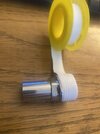- Joined
- 4 Jan 2012
- Messages
- 307
- Reaction score
- 6
- Country

Hi guys,
After some searching and Googling it seems Im not the only person who is or has had this issue. Fitting a tail into a radiator you can literally screw it all the way past the end of the rad given the tolerance of the tail and the thread in the valve they can be off slightly and weep.
I know I can wrap PTFE around the thread to fill the gap but this method seems a bit of a faff and it would seem others have used liquid PTFE or a compression valve. Not to over engineer but is there an issue if I use both (given just the compression valve on its own may not be enough - unless Im wrong?)
Thanks!
After some searching and Googling it seems Im not the only person who is or has had this issue. Fitting a tail into a radiator you can literally screw it all the way past the end of the rad given the tolerance of the tail and the thread in the valve they can be off slightly and weep.
I know I can wrap PTFE around the thread to fill the gap but this method seems a bit of a faff and it would seem others have used liquid PTFE or a compression valve. Not to over engineer but is there an issue if I use both (given just the compression valve on its own may not be enough - unless Im wrong?)
Thanks!


